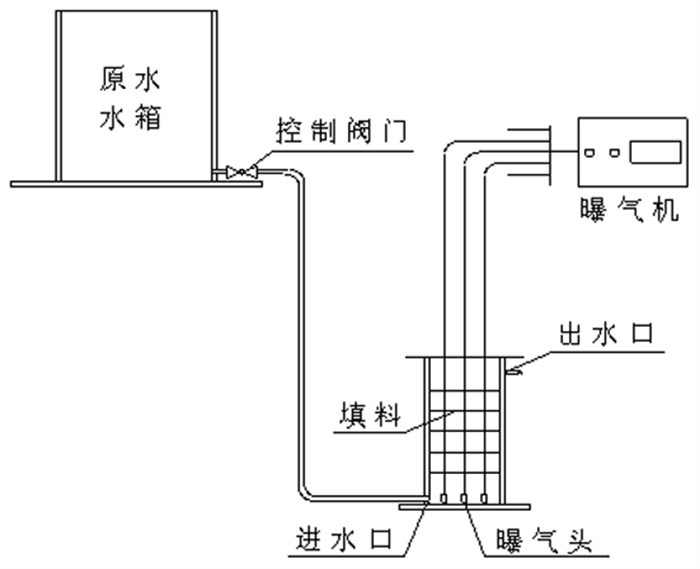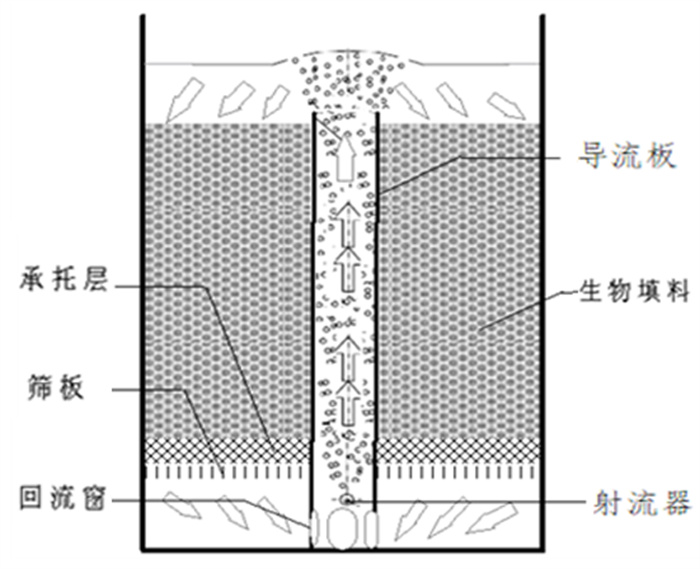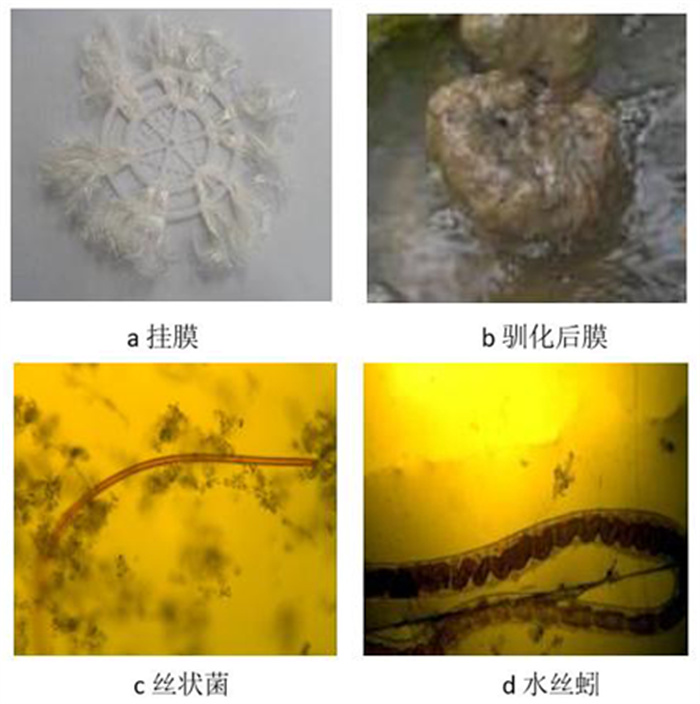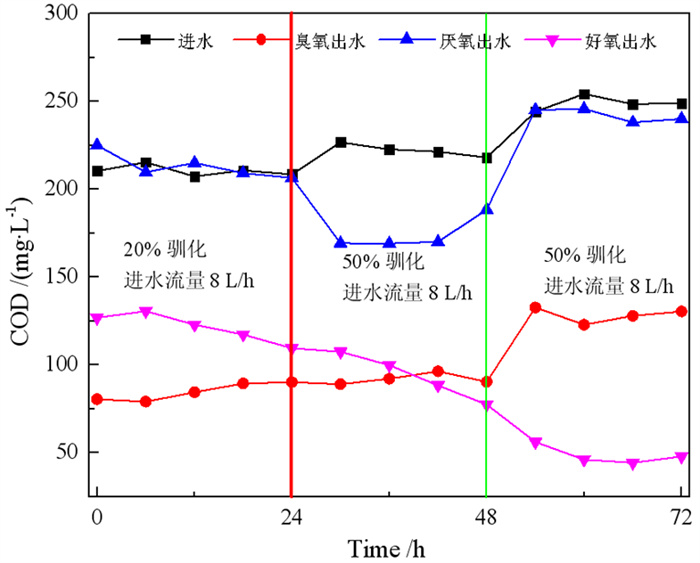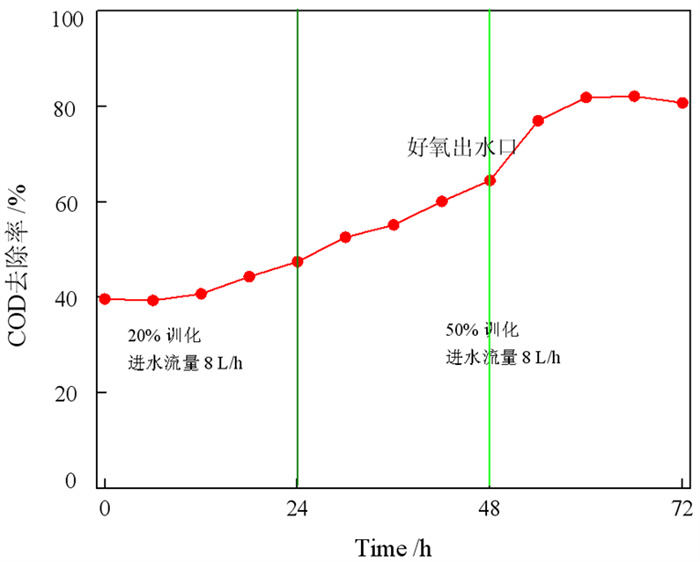Ozone Oxidation-biochemical Method Combined Treatment of Fankou Lead-zinc Mine Wastewater and Recycling
-
摘要:
基于凡口铅锌矿选矿废水特性的解析及技改需要,以"初期氧化+预处理+生化处理法"工艺处理选矿废水。通过研究不同O3浓度、催化氧化时间和不同水力停留时间(HRT)对废水处理效果的影响,考察处理后废水回用对选矿指标的影响,评估该工艺的可行性。结果表明,初期氧化阶段,利用O3直接或间接氧化废水中残留药剂;协同预处理去除废水中Ca2+和重金属;后续的生化处理进一步提升出水质量。在O3浓度为60 mg/L,催化氧化时间为20 min,水力停留时间为16.71 h,能够将废水COD浓度降至为34.32 mg/L,去除率为91.9%;HRT和O3浓度的增加对废水处理效果显著;将处理后废水回用于选矿工艺,与清水的选矿指标接近。该工艺在运行稳定下不仅能够实现选矿废水高效处理和回用,处理成本较低为2.65元/m3,该工艺可为国内类似铅锌选厂废水的处理及回用提供借鉴。
Abstract:This study was analyzing the beneficiation wastewater of Fankou lead-zinc mine and meeting the technical upgrade requirements, the research on the treatment of wastewater with the technology of "initial oxidation+pretreatment+biochemical treatment" was carried out to explore the wastewater with different ozone, catalytic oxidation time and different hydraulic retention time. Moreover, the influence of wastewater reuse after treatment on mineral processing index was investigated, and the feasibility of the process was evaluated. The results show that O3 was used to directly or indirectly oxidize the residual organic chemicals in the wastewater in the initial oxidation, ; the co-pretreatment removes Ca2+ and heavy metals in the wastewater; the subsequent biochemical treatment further improves the quality of the water. In addition, the ozone concentration is 60 mg/L, the catalytic oxidation time is 20 min, and the hydraulic retention time is 16.71 h, which can reduce the wastewater COD concentration to 34.32 mg/L, and the removal rate is 91.9%. Further research shows that the increase in hydraulic retention time and ozone concentration significantly improves the wastewater treatment effect. Reusing the treated wastewater for ore beneficiation can effectively eliminate the influence of reused water on the instability factors of ore beneficiation, and it is close to the beneficiation index of clean water. Under stable operation, this process can not only realize the efficient treatment and reuse of mineral processing wastewater, but also has a lower processing cost of 2.65 ¥/m3, which can provide usable technical experience for the reuse of wastewater from domestic lead-zinc processing plants.
-

-
表 1 水力停留时间方案
Table 1. Hydraulic retention time scheme
工艺阶段 HRT /h 方案1 方案2 方案3 进水 2.25 1.7 0.85 臭氧出水 1.13 0.8 0.42 厌氧出水 10 8 4 好氧出水 3.33 2.5 1.25 注:进水,指选矿废水进入臭氧催化反应器的阶段;臭氧出水,指水臭氧催化反应器阶段;厌氧出水,预处理阶段和厌氧反应阶段;好氧出水,水好氧反应阶段;HRT,水力停留时间。 表 2 废水水质分析
Table 2. water quality analysis
/(mg·L-1) 成分 固含率/% pH COD TOC Fe2+ Pb Zn Cu Cr 硫尾水 0 6.85 642.24 15.63 0.353 4.45 7.27 nd nd 2#池水 0.006 7 12.19 367.24 19.65 0.197 1.44 nd nd nd 硫精水 0.011 6 8.04 314.65 35.98 0.119 0.86 nd nd nd 试验用水 0.006 2 10.07 397.45 21.29 0.211 1.872 1.073 nd nd 成分 Cd Mn K+ Na+ Ca2+ F- Cl- SO42- NO3- 硫尾水 nd 2.17 122.98 32.17 809.4 0.46 13.23 84.70 30.80 2#池水 nd nd 43.96 13.39 578.3 0.66 3.95 65.19 17.50 硫精水 nd 0.26 51.91 15.32 664.8 nd 2.51 54.56 13.75 试验用水 nd 0.352 57.19 16.83 628.46 0.52 5.19 65.39 19.107 表 3 不同水力停留时间对COD去除的影响
Table 3. Effect of different hydraulic retention time on COD removal
方案 名称 COD/(mg·L-1) 去除率/% HRT/h 进水 424.44 - 2.25 臭氧出水 151.96 64.2 1.13 方案1 厌氧出水 141.48 66.7 10 好氧出水 34.32 91.9 3.33 进水 445.4 1.7 臭氧出水 145.9 67.2 0.8 方案2 厌氧出水 138.2 68.9 8 好氧出水 62.16 86.1 2.5 进水 460.8 0.85 臭氧出水 253.44 45.0 0.42 方案3 厌氧出水 207.2 55.0 4 好氧出水 51.26 88.9 1.25 表 4 出水水质分析
Table 4. Analysis of effluent quality
/(mg·L-1, 除pH外) 出水 pH Ca Fe Cu Zn Pb CODcr NH3-N TP SS 本工艺 7.10 655 2.14 1.52 0.71 1.44 35.4 10.3 0.48 15.5 对比1 6.52 712 3.05 1.43 0.88 1.26 52.1 15.2 0.55 37.8 对比2 4.55 805 3.67 1.99 0.52 1.70 80.5 12.6 1.41 55.1 表 5 废水处理回用选矿试验结果
Table 5. test results of wastewater treatment and reuse beneficiation
产品 Q/g γ/% 品位/% 金属量 回收率/% Pb Zn Pb Zn Pb Zn K铅精矿 95.50 6.03 61.95 2.45 373.5 14.8 84.4 1.7 清水 K锌精矿 226.00 14.27 1.01 58.47 14.4 834.3 3.3 95.3 尾矿 1 262.40 79.70 0.68 0.33 54.5 26.0 12.3 3.0 原矿 1 583.9 442.4 875.1 100.0 100.0 K铅精矿 98.50 6.20 60.94 2.31 378.0 14.3 83.8 1.6 本工艺 K锌精矿 227.00 14.30 1.21 58.16 17.4 831.4 3.8 95.5 尾矿 1 262.40 79.50 0.70 0.32 55.6 25.2 12.3 2.9 原矿 1 587.9 450.9 870.9 100.0 100.0 K铅精矿 115.00 7.34 54.31 3.58 398.8 26.3 87.7 3.0 对比1 K锌精矿 240.00 15.33 0.56 51.75 8.6 793.1 1.9 91.8 尾矿 1 211.00 77.33 0.61 0.58 47.2 44.9 10.4 5.2 原矿 1 566 454.6 864.2 100.0 100.0 K铅精矿 132.00 8.46 49.19 3.52 416.0 29.8 91.3 3.4 对比2 K锌精矿 269.00 17.23 0.37 47.02 6.4 810.3 1.4 93.8 尾矿 1 160.00 74.31 0.45 0.32 33.4 23.6 7.3 2.7 原矿 1 561 455.8 863.6 100.0 100.0 表 6 小试试验经济成本核算
Table 6. economic cost accounting of pilot test
项目 臭氧成本 生化成本 活性炭成本 砂滤成本 药剂成本 总计 参考文献 费用/ (元·m3) 1.0 0.6 0.5 0.3 0.25 2.65 本研究 统计结果 2.20 [20] 调查结果 2~3 [21] 注:臭氧成本是基于经验成本。 -
[1] 史宇驰, 邹勤, 陶镇, 等. 湖南某多金属矿选矿废水处理回用试验研究[J]. 中国钨业, 2015, 30(5): 34-38. doi: 10.3969/j.issn.1009-0622.2015.05.006
[2] 顾泽平. 含苯胺黑药废水的物化净化特性研究[D]. 广州: 广东工业大学, 2006: 41-42.
[3] 张辉, 周晓彤, 邱显扬. 多金属硫化矿选矿废水处理的研究现状[J]. 材料研究与应用, 2015, 9(4): 226-230. doi: 10.3969/j.issn.1673-9981.2015.04.004
[4] 张东方, 陈涛. 接触氧化法处理铅锌矿选矿废水试验研究[J]. 广东化工, 2012, 39(6): 285-287. doi: 10.3969/j.issn.1007-1865.2012.06.154
[5] 敖顺福. 典型铅锌选矿厂废水零排放工艺对比分析[J]. 矿产保护与利用, 2021, 41(1): 38-45. http://kcbh.cbpt.cnki.net/WKD/WebPublication/paperDigest.aspx?paperID=260f7f81-fd8f-4e18-8b3b-f12425818d7b
[6] 陈伟, 彭新平, 陈代雄. 某铅锌矿选矿废水处理复用与零排放试验研究[J]. 环境工程, 2011, 29(3): 37-39. https://www.cnki.com.cn/Article/CJFDTOTAL-HJGC201103013.htm
[7] 杨建文. 盘龙铅锌矿铅锌选矿废水处理及循环回用研究[J]. 有色金属工程, 2018(2): 133-138. https://www.cnki.com.cn/Article/CJFDTOTAL-YOUS201802027.htm
[8] 华金铭, 魏可镁, 郑起, 等. 物化-生化组合工艺处理提铜选矿药剂生产废水中试验研究[J]. 环境工程学报, 2013, 7(1): 207-213. https://www.cnki.com.cn/Article/CJFDTOTAL-HJJZ201301039.htm
[9] 张辉, 周晓彤, 邱显扬. 多金属硫化矿选矿废水处理的研究现状[J]. 材料研究与应用, 2015, 9(4): 226-230. doi: 10.3969/j.issn.1673-9981.2015.04.004
[10] 严群, 桂勇刚, 周娜娜, 等. 混凝沉淀法处理含砷选矿废水[J]. 环境工程学报, 2014, 8(9): 3683-3688. https://www.cnki.com.cn/Article/CJFDTOTAL-HJJZ201409026.htm
[11] 张艳, 戴晶平, 张康生. 凡口矿选矿废水处理与利用试验研究[J]. 矿冶工程, 2008, 28(3): 45-48. doi: 10.3969/j.issn.0253-6099.2008.03.012
[12] 黄红军. 广东某铅锌矿选矿废水资源化处理[J]. 矿产综合利用, 2012(2): 37-42. https://www.cnki.com.cn/Article/CJFDTOTAL-KCZL201202012.htm
[13] 冯秀娟, 刘祖文, 朱易春. 混凝剂处理选矿废水的研究[J]. 矿冶工程, 2005, 25(4): 27-29. doi: 10.3969/j.issn.0253-6099.2005.04.008
[14] 王自超, 刘兴宇, 宋永胜. 臭氧生物活性炭工艺处理某多金属硫化矿浮选废水的小试研究[J]. 环境工程学报, 2013, 7(5): 1723-1728. https://www.cnki.com.cn/Article/CJFDTOTAL-HJJZ201305025.htm
[15] 阳承胜, 蓝崇钰. 宽叶香蒲人工湿地对铅/锌矿废水净化效能的研究[J]. 深圳大学学报: 理工版, 2000(Z1): 51-57. https://www.cnki.com.cn/Article/CJFDTOTAL-SZDL2000Z1009.htm
[16] 林伟雄, 许娉婷, 武纯. 采用浸没式膜生物反应器处理苯胺黑药浮选废水[J]. 中国有色金属学报, 2016(11): 2461-2468. https://www.cnki.com.cn/Article/CJFDTOTAL-ZYXZ201611024.htm
[17] Gunten, U. V. (2003). Ozonation of drinking water: part I. Oxidation kinetics and product formation[J]. Water Research, 2003, 37(7): 1443-1467. doi: 10.1016/S0043-1354(02)00457-8
[18] 王亮华, 许伟航, 傅平丰, 等. 浮选废水中共存离子对臭氧氧化苯胺黑药的影响研究[J]. 矿产保护与利用, 2021, 41(1): 1-8. http://kcbh.cbpt.cnki.net/WKD/WebPublication/paperDigest.aspx?paperID=a912f08e-6ddb-4710-8752-3323066a31fd
[19] 姜智超, 余侃萍, 张玉凤. 臭氧氧化-循环喷淋法处理钨钼选矿废水[J]. 矿冶工程, 2020, 40(3): 75-78. doi: 10.3969/j.issn.0253-6099.2020.03.020
[20] 雷金勇, 王利国, 黄伟, 等. 铅锌矿选矿废水的节水工艺与重金属的低成本处理技术[J]. 资源节约与环保, 2016(6): 64-65. doi: 10.3969/j.issn.1673-2251.2016.06.046
[21] 潘菊芬. 铅锌矿选矿废水的节水工艺与重金属的低成本处理技术分析[J]. 世界有色金属, 2018(5): 24-25. https://www.cnki.com.cn/Article/CJFDTOTAL-COLO201805014.htm
-




 下载:
下载:
